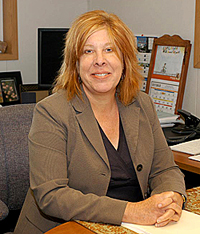
| CONNECTIONS |
IDAHO
ITD
HOME
511 TRAVEL SERVICES
IDAHO
DMV
ITD
NEWS
HIGHWAY
SAFETY
IDAHO STATE POLICE
STATE OF IDAHO
NIATT
NATIONAL
AASHTO
AAMVA
AAA of IDAHO
FEDERAL HIGHWAYS
FEDERAL AVIATION
IDAHO STATE POLICE
NHTSA
NTSB
TRB
U.S. DOT
TRANSPORTER
Archives
Milestones
Comments
Idaho
Transportation
Department
Office of Communications
P.O. Box 7129
Boise, ID 83707
208.334.8005
Fax: 208.334.8563

OHOS picks new highway safety manager from own ranks
When the Office of Highway Operations and Safety (OHOS) began looking for a new highway safety manager the search didn’t to go far – only about 50 feet.
Share Maack was recently appointed to the position responsible for overseeing highway safety office activities. Maack was previously an OHOS grants officer managing pedestrian, bicyclist and motorcyclist safety programs in addition to the office’s EMS grant program.
 Born and raised in Wisconsin, she began her career as a social worker and went on to manage and administer several non-profit programs and grants. After earning a master’s degree in environmental science from Miami University in Oxford, Ohio, with an emphasis in policy and administration, she worked for federal and state agencies in Washington, D.C., Minnesota, Ohio and Africa, in addition to Idaho.
Born and raised in Wisconsin, she began her career as a social worker and went on to manage and administer several non-profit programs and grants. After earning a master’s degree in environmental science from Miami University in Oxford, Ohio, with an emphasis in policy and administration, she worked for federal and state agencies in Washington, D.C., Minnesota, Ohio and Africa, in addition to Idaho.
In 1999, she was elected to the city council in Takoma Park, Md., where she helped direct a $13 million budget providing services to 16,000 residents.
“While a city council member, I had numerous opportunities to work with the Maryland Department of Transportation and local police officers,” she said.
“A highlight of my early career was working as a foreign service officer for the United States Agency for International Development where I assisted local communities and local governments in finding solutions to economic and environmental issues,” she said.
Maack moved to Boise in 2004 after an extensive search for a place to live; she admits being “very happy” with the choice.
Since joining ITD last year, she has faced many of the challenges confronting OHOS. Leading those challenges is funding.
“Idaho has one of the lowest-funded highway safety offices in the country,” she explained. “Part of that is based on the state’s lower population and fewer federal highway miles. Another part is related to the strength of the state’s highway safety laws, which directly affects Idaho’s ability to apply for additional highway funding.”
Working closely with local communities will be one of her top OHOS priorities.
“We’re looking for new ways to take the highway safety message into communities and at the same time seek additional highway safety partners,” she said. “We hope to achieve more public/private partnerships as part of increasing local community involvement.”
“As planners and district engineers work with local communities and see or learn about local safety issues, we (OHOS) encourage them to have those communities contact us.”
While working as an ITD grants officer she found local communities very appreciative of OHOS efforts.
“I consider it a privilege to have been able to work on EMS grants. For example, providing hydraulic extraction equipment (Jaws of Life) and see the impact that has on local communities.”
Other priorities include improving the OHOS Web site and offering more demonstration grants.
“If local communities have new ways of spreading highway safety messages, we’re interested and willing to support those efforts with demonstration grants,” she said.
She said she hopes to help people in local communities better understand what OHOS does. The office is responsible for administering federal highway safety grants, managing highway safety programs, maintaining a statewide collision database and disseminating educational materials.
“One of the challenges of the job is trying to translate data into something motivational,” she explained. “We need to look at presenting data in ways that educate people and ultimately changes behavior.”
Published 11-02-07